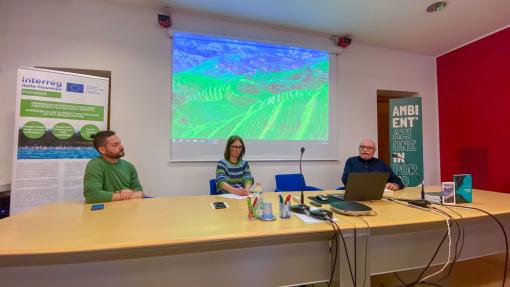On Saturday 15th March, as part of the POSEIDONE: Biodiversità e Territori in Scena (POSEIDONE: Biodiversity and Landscapes on Stage) project, a meeting was held in the Conference Room of VeGAL dedicated to the theme of landscape and its connection with biodiversity.
The event, part of the Festival Ambient'Azione in Porto, proposed a reflection on the concept of landscape, understood not only as a natural scenario, but as the result of a complex interweaving of perceptions, experiences and collective memory.
An attentive and engaged audience listened to the dialogue, moderated by Ivano Marcorin of Legambiente Veneto Orientale, between Elisa Cozzarini and Carlo Rubini, authors of the books ‘Gli Intrecci del Fiume’ and ‘Microcosmi e Paesaggi’, both published by Ediciclo. The authors offered numerous points for reflection that broadened the concept of landscape, distinguishing it from terms often used as synonyms, such as environment or territory.
‘The landscape is not only what we see, but what we experience and perceive’, explained Rubini. “It is not a neutral background, but a mosaic of natural and cultural elements that are transformed over time, shaped by our gaze and our experiences”.
Rubini recalled an episode from his childhood, related to his train journey over the Casarsa Bridge, which as a child had always left him perplexed. ‘I looked down from the bridge and saw only expanses of gravel,’ he said. ‘I asked my father what it was and he said, “the Tagliamento”.’ Only later would Carlo discover that under those stones flowed an invisible current, hidden from view, an underground watercourse increasingly impoverished because much of the water was taken for agricultural use.
Cozzarini, on the other hand, emphasised how rivers and water are at the centre of his narratives, symbols of the connection between past and present. ‘The sound of the water flowing in the irrigation ditch near my house was a reassuring constant, a “white noise” that accompanied my days and that I learned to recognise as an integral part of my familiar landscape’.
One of the central themes that emerged during the discussion was the role of perception in defining the landscape. Rubini emphasised how our gaze can be deceptive and partial. In this sense, natural landscapes risk becoming consumerist images, simplified and emptied of their true meaning. ‘What becomes a mass phenomenon tends to lose its authenticity,’ Rubini observed, highlighting how tourist and commercial rhetoric often trivialises the identity of places.
The discussion then touched on the delicate relationship between landscape and biodiversity. The two authors emphasised how the transformation of the territory, due to urban expansion and mass tourism, also puts the ecological and cultural balance of North-Eastern Italy at risk.
The authors emphasised that biodiversity is an integral part of the landscape, and that when the environment is not respected, not only is the ecosystem altered, but also a part of the collective memory linked to that place is erased.
A concrete example of this fragility is represented by waterways, which are often victims of invasive interventions that compromise their ecological function. However, if carefully managed, rivers can become real ecological corridors that favour the conservation of species and the regeneration of the landscape.
The meeting ended with an invitation to rediscover the narrative dimension of the landscape. Through stories, testimonies and collective memory, a deeper awareness of the environmental and social value of the land can be built. The dialogue left the participants with a valuable insight: taking care of the landscape means not only protecting the environment and its biodiversity, but also preserving the stories, identities and bonds that give life to our land.

